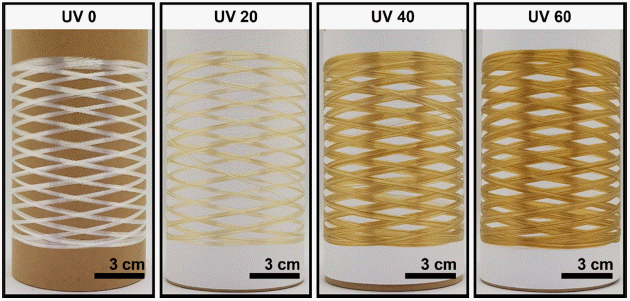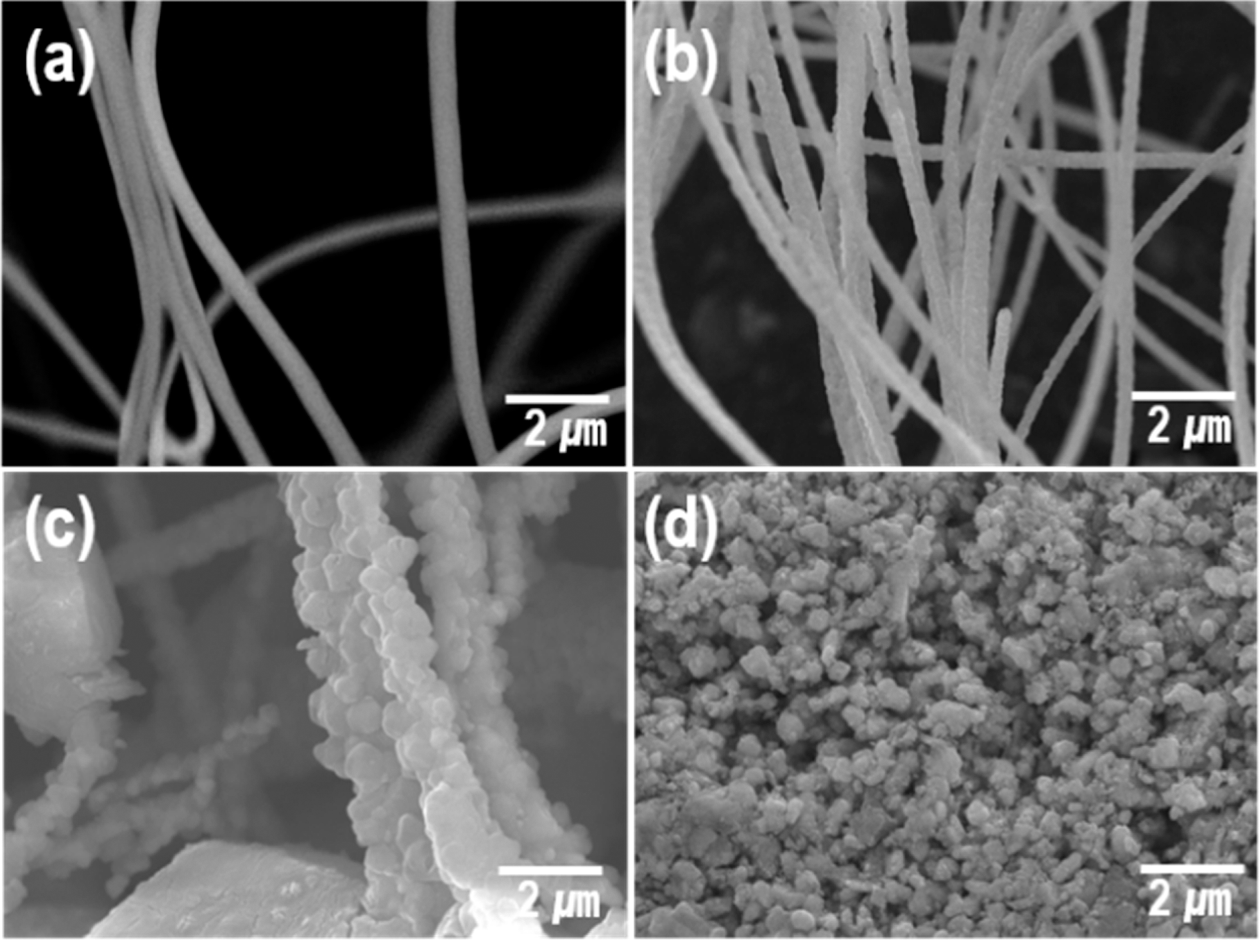Search
- Page Path
- HOME > Search
- [Korean]
- Developing Continuous Stabilization Process for Textile-Grade PAN Fiber-Based Carbon Fiber Using UV Irradiation
- Joon Ha Moon, Honggyu Seong, Jiseon Yoo, Se Youn Cho, Jaewon Choi
- J Powder Mater. 2022;29(5):418-423. Published online October 1, 2022
- DOI: https://doi.org/10.4150/KPMI.2022.29.5.418

- 365 View
- 3 Download
-
 Abstract
Abstract
 PDF
PDF Carbon fibers (CFs) are considered promising composite materials for various applications. However, the high cost of CFs (as much as $26 per kg) limits their practical use in the automobile and energy industries. In this study, we developed a continuous stabilization process for manufacturing low-cost CFs. We employed a textile-grade polyacrylonitrile (PAN) fiber as a low-cost precursor and UV irradiation technique to shorten the thermal stabilization time. We confirmed that UV irradiation on the textile-grade PAN fibers could lower the initial thermal stabilization temperature and also lead to a higher reaction. These resulted in a shorter overall stabilization time and enhancement of the tensile properties of textilegrade PAN-based CFs. Our study found that only 70 min of stabilization time with UV irradiation was required to prepare textile-grade PAN-based low-cost CFs with a tensile strength of 2.37 ± 0.22GPa and tensile modulus of 249 ± 5 GPa.
- [Korean]
- Synthesize of Nd2Fe14B Powders from 1-D Nd2Fe14B Wires using Electrospinning Process
- Nu Si A Eom, Su Noh, Muhammad Aneeq Haq, Bum Sung Kim
- J Korean Powder Metall Inst. 2019;26(6):477-480. Published online December 1, 2019
- DOI: https://doi.org/10.4150/KPMI.2019.26.6.477

- 282 View
- 1 Download
- 1 Citations
-
 Abstract
Abstract
 PDF
PDF Magnetic 0-D Nd2Fe14B powders are successfully fabricated using 1-D Nd2Fe14B nanowire formed by an efficient and facile electrospinning process approach. The synthesized Nd-Fe-B fibers and powders are investigated for their microstructural, crystallographic, and magnetic properties according to a series of subsequent heat treatments. Each heat-treatment process leads to the removal of organic impurities and the formation of the respective oxides/composites of Nd, Fe, and B, resulting in the formation of Nd2Fe14B powders. Nd-Fe-B fibers exhibit the following magnetic properties: The coercivity (Hci) of 3260 Oe, a maximum magnetization at 3T of 109.44 emu/g, and a magnetization remanence (Mr) of 44.11 emu/g. This process easily mass produces hard magnetic Nd2Fe14B powders using a 1-D synthesis process and can be extended to the experimental design of other magnetic materials.
-
Citations
Citations to this article as recorded by- Nd2Fe14B/FeCo Core–Shell Nanoparticle Synthesis Using Galvanic Substitution Based Electroless Plating
Muhammad Aneeq Haq, Han-Saem Lee, Mi Hye Lee, Da-Woon Jeong, Eom Nu Si A, Bin Lee, Yoseb Song, Bum Sung Kim
Coatings.2022; 12(3): 389. CrossRef
- Nd2Fe14B/FeCo Core–Shell Nanoparticle Synthesis Using Galvanic Substitution Based Electroless Plating
- [English]
- Study of Fabrication and Improvement of Mechanical Properties of Mg-based Inorganic Fiber using Reflux Process and Silica Coating
- Ri Yu, YooJin Kim
- J Korean Powder Metall Inst. 2019;26(3):195-200. Published online June 1, 2019
- DOI: https://doi.org/10.4150/KPMI.2019.26.3.195

- 372 View
- 1 Download
- 3 Citations
-
 Abstract
Abstract
 PDF
PDF Whisker-type magnesium hydroxide sulfate hydrate (5Mg(OH)2·MgSO4·3H2O, abbreviated 513 MHSH), is used in filler and flame-retardant composites based on its hydrate phase and its ability to undergo endothermic dehydration in fire conditions, respectively. In general, the length of whiskers is determined according to various synthetic conditions in a hydrothermal reaction with high temperature (~180°C). In this work, high-quality 513 MHSH whiskers are synthesized by controlling the concentration of the raw material in ambient conditions without high pressure. Particularly, the concentration of the starting material is closely related to the length, width, and purity of MHSH. In addition, a ceramic-coating system is adopted to enhance the mechanical properties and thermal stability of the MHSH whiskers. The physical properties of the silica-coated MHSH are characterized by an abrasion test, thermogravimetric analysis, and transmission electron microscopy.
-
Citations
Citations to this article as recorded by- Effect of sulfate ion on synthesis of 5 Mg(OH)2·MgSO4·3H2O whiskers using non-hydrothermal method with acid catalyst
Areum Choi, Nuri Oh, YooJin Kim
Journal of the Korean Ceramic Society.2022; 59(2): 224. CrossRef - Study of SiO2 coating and carboxylic surface-modification on Mg-based inorganic fiber by one-step reflux reaction
Minsol Park, Areum Choi, Seiki Kim, Wooyoung Shim, YooJin Kim
Journal of the Korean Ceramic Society.2022; 59(6): 869. CrossRef - Effect of H2SO4 and Reaction Time on Synthesis of 5Mg(OH)2∙MgSO4∙3H2O Whiskers using Hydrothermal Reaction
Areum Choi, Nuri Oh, YooJin Kim
Journal of Korean Powder Metallurgy Institute.2020; 27(5): 401. CrossRef
- Effect of sulfate ion on synthesis of 5 Mg(OH)2·MgSO4·3H2O whiskers using non-hydrothermal method with acid catalyst
- [English]
- Microwave Absorbance of Polymer Composites Containing SiC Fibers Coated with Ni-Fe Thin Films
- Tian Liu, Sung-Soo Kim, Woo-cheal Choi, Byungil Yoon
- J Korean Powder Metall Inst. 2018;25(5):375-378. Published online October 1, 2018
- DOI: https://doi.org/10.4150/KPMI.2018.25.5.375

- 247 View
- 4 Download
- 1 Citations
-
 Abstract
Abstract
 PDF
PDF Conductive and dielectric SiC are fabricated using electroless plating of Ni–Fe films on SiC chopped fibers to obtain lightweight and high-strength microwave absorbers. The electroless plating of Ni–Fe films is achieved using a two-step process of surface sensitizing and metal plating. The complex permeability and permittivity are measured for the composite specimens with the metalized SiC chopped fibers dispersed in a silicone rubber matrix. The original noncoated SiC fibers exhibit considerable dielectric losses. The complex permeability spectrum does not change significantly with the Ni–Fe coating. Moreover, dielectric constant is sensitively increased with Ni–Fe coating, owing to the increase of the space charge polarization. The improvements in absorption capability (lower reflection loss and small matching thickness) are evident with Ni–Fe coating on SiC fibers. For the composite SiC fibers coated with Ni–Fe thin films, a -35 dB reflection loss is predicted at 7.6 GHz with a matching thickness of 4 mm.
-
Citations
Citations to this article as recorded by- Magnetic sputtering of FeNi/C bilayer film on SiC fibers for effective microwave absorption in the low-frequency region
Tong Guo, Ben Huang, Changgeng Li, Yumin Lou, Xiu-Zhi Tang, Xiaozhong Huang, Jianling Yue
Ceramics International.2021; 47(4): 5221. CrossRef
- Magnetic sputtering of FeNi/C bilayer film on SiC fibers for effective microwave absorption in the low-frequency region
- [Korean]
- Spindle-shaped Fe2O3 Nanoparticle Coated Carbon Nanofiber Composites for Low-cost Dye-sensitized Solar Cells
- Dong-Hyeun Oh, HyeLan An, Bon-Ryul Koo, Hyo-Jin Ahn
- J Korean Powder Metall Inst. 2016;23(2):95-101. Published online April 1, 2016
- DOI: https://doi.org/10.4150/KPMI.2016.23.2.95

- 339 View
- 2 Download
- 1 Citations
-
 Abstract
Abstract
 PDF
PDF Carbon nanofiber (CNF) composites coated with spindle-shaped Fe2O3 nanoparticles (NPs) are fabricated by a combination of an electrospinning method and a hydrothermal method, and their morphological, structural, and chemical properties are measured by field-emission scanning electron microscopy, transmission electron microscopy, Xray diffraction, and X-ray photoelectron spectroscopy. For comparison, CNFs and spindle-shaped Fe2O3 NPs are prepared by either an electrospinning method or a hydrothermal method, respectively. Dye-sensitized solar cells (DSSCs) fabricated with the composites exhibit enhanced open circuit voltage (0.70 V), short-circuit current density (12.82 mA/cm2), fill factor (61.30%), and power conversion efficiency (5.52%) compared to those of the CNFs (0.66 V, 11.61 mA/cm2, 51.96%, and 3.97%) and spindle-shaped Fe2O3 NPs (0.67 V, 11.45 mA/cm2, 50.17%, and 3.86%). This performance improvement can be attributed to a synergistic effect of a superb catalytic reaction of spindle-shaped Fe2O3 NPs and efficient charge transfer relative to the one-dimensional nanostructure of the CNFs. Therefore, spindle-shaped Fe2O3-NPcoated CNF composites may be proposed as a potential alternative material for low-cost counter electrodes in DSSCs.
-
Citations
Citations to this article as recorded by- Ni Nanoparticles-Graphitic Carbon Nanofiber Composites for Pt-Free Counter Electrode in Dye-Sensitized Solar Cells
Dong-Hyeun Oh, Bon-Ryul Koo, Yu-Jin Lee, HyeLan An, Hyo-Jin Ahn
Korean Journal of Materials Research.2016; 26(11): 649. CrossRef
- Ni Nanoparticles-Graphitic Carbon Nanofiber Composites for Pt-Free Counter Electrode in Dye-Sensitized Solar Cells
- [Korean]
- Fabrication of WS2-W-WC Embedded Carbon Nanofiber Composites for Supercapacitors
- Yu-Jin Lee, Hyo-Jin Ahn
- J Korean Powder Metall Inst. 2015;22(2):116-121. Published online April 1, 2015
- DOI: https://doi.org/10.4150/KPMI.2015.22.2.116

- 275 View
- 2 Download
- 1 Citations
-
 Abstract
Abstract
 PDF
PDF WS2-W-WC embedded carbon nanofiber composites were fabricated by using electrospinning method for use in high-performance supercapacitors. In order to obtain optimum electrochemical properties for supercapacitors, WS2 nanoparticles were used as precursors and the amounts of WS2 precursors were controlled to 4 wt% (sample A) and 8 wt% (sample B). The morphological, structural, and chemical properties of all samples were investigated by means of field emission photoelectron spectroscopy, transmission electron microscopy, X-ray diffraction, and X-ray photoelectron spectroscopy. These results demonstrated that the embedded phases of samples A and B were changed from WS2 to WS2-W-WC through carbothermal reaction during carbonization process. In particular, sample B presented high specific capacitance (~119.7 F/g at 5 mV/s), good high-rate capacitance (~60.5%), and superb cycleability. The enhanced electrochemical properties of sample B were explained by the synergistic effect of the using 1-D structure supports, increase of specific surface area, and improved conductivity from formation of W and WC phases.
-
Citations
Citations to this article as recorded by- WS2 Nanoparticles Embedded in Carbon Nanofibers for a Pseudocapacitor
Ki-Wook Sung, Jung Soo Lee, Tae-Kum Lee, Hyo-Jin Ahn
Korean Journal of Materials Research.2021; 31(8): 458. CrossRef
- WS2 Nanoparticles Embedded in Carbon Nanofibers for a Pseudocapacitor
TOP
 kpmi
kpmi


 First
First Prev
Prev


